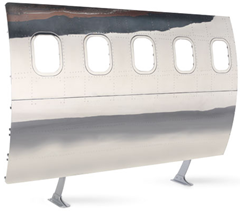Jason Schappert has posted the the next video in MzeroA’s Understanding Weather Series and this latest video focuses on thunderstorms and thunderstorm avoidance. In the video, Jason covers the two types of thunderstorms (air mass and steady state), the three ingredients it takes to make one (sufficient water vapor, unstable lapse rate or change in temperature rate and uplifting action), the three stages of thunderstorms (cumulus, mature and dissipating stages) and tips for avoidance (stay 20 miles away, avoid flying under the anvil of the storm and avoid attempting to fly over one as the top of a storm can be as much as 60,000 feet in altitude – in other words, much higher than you can fly in a normal aircraft!). The short video is well worth watching – especially by pilots in areas that experience frequent summer thunderstorms.
Introducing the Puffin: An electric-powered “flying suit”
Here is a video about an interesting design or idea that was set to be unveiled this week at an American Helicopter Society meeting in San Francisco. The Puffin is an experimental one-man electric helicopter or “flying suit” from NASA’s Langley Research Center and as Scientific American magazine recently noted:
As a pilot prepares to take off, flaps on the wings would tilt to deflect air from the 2.3-meter-wide propeller rotors upward, keeping the plane on the ground until it was ready to fly and preventing errant gusts from tipping it over. The Puffin would rise, hover and then lean over to fly horizontally, with the pilot lying prone as if in a glider. When landing, the extending spring legs would support the 3.7-meter-long, 4.1-meter-wingspan craft, which is designed with carbon-fiber composites to weigh in at 135 kilograms, not including 45 kilograms of rechargeable lithium phosphate batteries.
The Puffin, in theory, can cruise at 240 kilometers per hour with a range of 80 kilometers, reach speeds of more than 480 kilometers per hour and because its electric, it has no flight ceiling.
Not a bad idea or design in theory and it looks like it could really ease someone’s commute in Los Angeles, but we must also ask: Can such an idea really “take-off”?
Will piloted aircraft soon be a thing of the past?
Scott Spangler has recently written an interesting post on Jetwhine entitled “UND Plants Seed of No-Pilot Airliners.” Apparently, the University of North Dakota (UND) is now offering a bachelor’s of science degree in aeronautics with a major in Unmanned Aircraft Systems Operations (in other words, UAVs) and Scott quoted Mike Nelson, the former fighter pilot who teaches the course, as saying: “The last fighter pilot’s already been born. The last fighter is being built.” Scott further stated in his post that he’d “hazard a guess that the same is true for airline pilots. (And can corporate pilots be far behind?)”
On the other hand, Norman, a pilot who currently flies a Boeing 777 for a major UK carrier and who also writes for the Digital Aviator blog, strongly disagreed with Scott’s notion that pilots may be an endangered species. In a recent post written in response to Scott, Norman wrote:
One inhibitor is ever increasing traffic densities robbing the system of flex and airspace, another sovereignty based issues. Another still and by far the major hurdle is the huge investment that would be required in ground support infrastructure. We can’t yet fund and set up something as simple as a satellite based ATC communications system to manage the Atlantic or Africa, what makes us think we will be able to put in place the agreements and kit required to intermix and manage automated airliners internationally? It may happen, but not for a very long time yet – I would stake my job and even my rocking chair on it!
Norman also pointed out that the public is probably not ready for pilotless airliners.
Hence, what do you think? Are pilotless aircraft outside of the military really in the near or even the more distant future? If so, who (besides fighter pilots) might be replaced i.e. airline pilots, corporate pilots, other types of pilots etc.? We would love to hear what you think.
MotoArt: Sculpture and furniture out of old airplane parts
Hat tip to the Winged Victory Women in Aviation Webzine for posting a link to MotoArt – a California based design firm that makes art and furniture out of used airplane parts. Apparently, artist and aviation buff Donovan Fell III had spotted some old and dented B-17 propellers that were in the back of a metal junk man’s scrap pile and destined for the scrap heap. This gave him an idea and he spent a few weekends degreasing, sanding and polishing the blades in beautiful artistic sculptures. Eventually, his new hobby became a full time and lucrative business making artwork and furniture pieces such as bars, beds, credenzas, desks, tables and chairs. And as you can see from some of the creations below, it is amazing what can be done with an imagination and old airplane parts!
Understanding weather fronts video
Pilots need to have a good grasp and understanding of basic weather conditions that they may encounter in the air. Hence, Jason Schappert, the blogger behind the MzeroA.com blog, has begun a new “understanding weather” video series where he will be going over various weather conditions and how they impact pilots. Jason’s first video covers weather fronts and he begins by explaining what an air mass is and what a front is and then he explains the four most common types of fronts. The video is less than five minutes long and well worth watching as a reminder of what pilots face while flying.
VFR departure briefing simulator video
John Fiscus, the Chief Pilot of The Flight Academy, has recently posted a video on to the Cirrus Owners & Pilots Association (COPA) website where he demonstrates a VFR departure briefing and then a departure which utilizes some of that briefing. In his post, John made an interesting point that:
Many people I train with aren’t as ready as they ought to be for anything beyond the norm to happen in those first few seconds of flight. Performing a VFR departure briefing is a good way to prepare for the unexpected… and ensure the appropriate (and timely) reaction!
He also noted that:
A VFR departure briefing is going to be difficult for most established pilots to start performing. I have heard the excuses, but they really boil down to, "I have been flying this long and it works fine. I know what to do if something happens, I can handle this."
However, John then mentioned that when he see pilots doing simulator training, many aren’t all that prepared to make a tough call fast. Furthermore, he noted that many experienced Cirrus pilots don’t pull the CAPS handle soon enough – especially when a low altitude engine failure is simulated and time is short.
The video is less than six minutes long and hence is worth watching.




